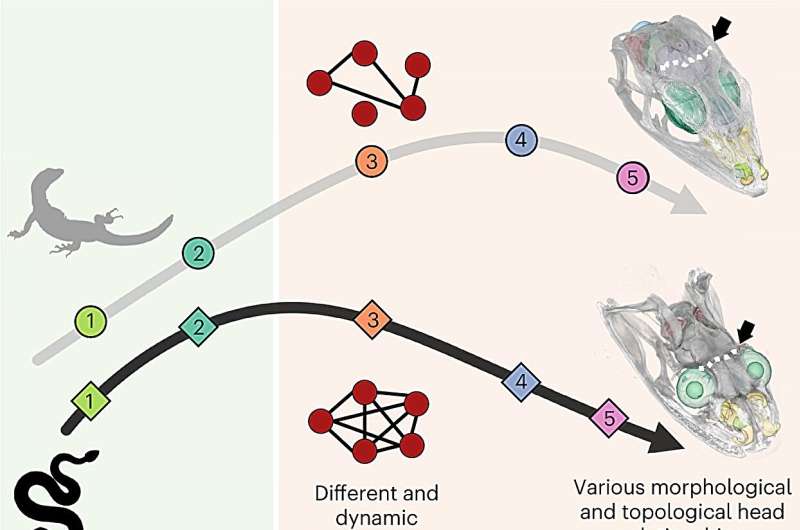This article has been reviewed according to Science X's editorial process and policies. Editors have highlighted the following attributes while ensuring the content's credibility:
fact-checked
peer-reviewed publication
trusted source
proofread
From embryo to evolution: Insights from the head of lizards and snakes

The evolution of animal heads is a remarkable example of how various anatomical features co-evolved to adapt to different ecological niches, behaviors and functions. But the intricate details of why vertebrate head shapes vary so greatly have remained elusive.
The crux of the issue lies in the high anatomical diversity and complex nature of animal growth and development, often exacerbated by studies focusing solely on specific stages of an animal's life or isolated components of the head, particularly in adulthood.
In a collaborative effort, researchers from the HiLIFE Institute of Biotechnology, University of Helsinki, in conjunction with international collaborators, delved into the exceptional morphological diversity of squamate reptiles, including lizards and snakes, to unravel the long-standing mystery surrounding the diverse shapes of vertebrate heads. Their comprehensive analysis covered head development from early embryonic formation to fully formed bones and organs in adults.
The work is published in the journal Nature Ecology & Evolution.
This research underscores the importance of understanding the growth of embryos, overall organism development, and the intricate interactions between different tissues in shaping vertebrate heads.
By meticulously comparing skull bone and soft tissue shapes, the findings illuminate a gradual emergence of distinctions between snake and lizard heads during their development. Various mechanisms, including the formation of shape and the speed of development, contribute to these differences.
"Our study provides a framework for future animal studies aiming to analyze patterns of skull and other tissue variation from an evolutionary and developmental perspective," says Principal Investigator Nicolas Di-Poï, Research Director at the Institute of Biotechnology, University of Helsinki.
"The origin of snake skulls has been linked to shifts in the timing of development. However, snake evolution is not solely explained by a single type of change. Multiple changes play a role in shaping their skulls and heads. In early embryos, snake development diverges from lizards in both shape and position, followed by timing differences in later stages," explains the first author of the study, Doctoral Researcher Joni Ollonen.
The study also reveals dynamic changes in how skull bones integrate with surrounding brain tissues and sensory organs.
"What's fascinating is that snakes have a more integrated head during their development, where changes in one area affect others. This limits their head shapes during growth but allows their skulls to take extreme forms that lizard can't," describes Di-Poï.
Key areas around the eyes, nasal cavity, and Jacobson's organ prove pivotal in shaping how snake skulls form, emphasizing the significant role of changes in vital senses like vision, smell, and the specialized scent-detecting organ in snake evolution.
This research marks a significant step forward in unraveling the adaptive nature of reptile heads, providing valuable insights into how different skull bones and surrounding organs are connected in vertebrates. This newfound knowledge offers a glimpse into the fascinating world of how form, development and function are intricately connected in nature's diversity and design.
More information: Joni Ollonen et al, Dynamic evolutionary interplay between ontogenetic skull patterning and whole-head integration, Nature Ecology & Evolution (2024). DOI: 10.1038/s41559-023-02295-3
Journal information: Nature Ecology & Evolution
Provided by University of Helsinki



















